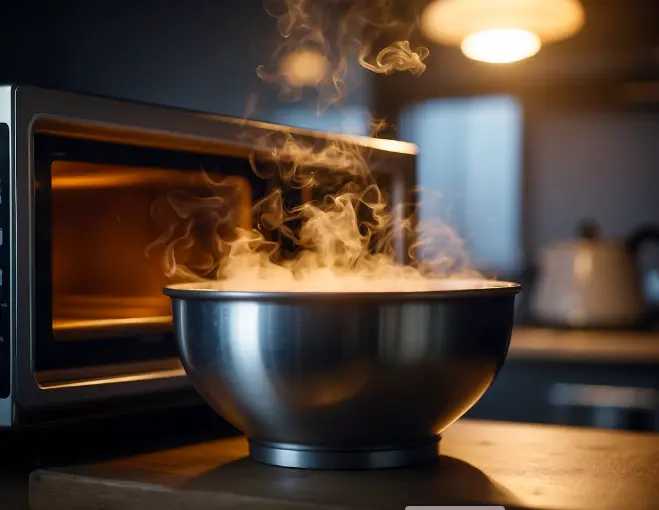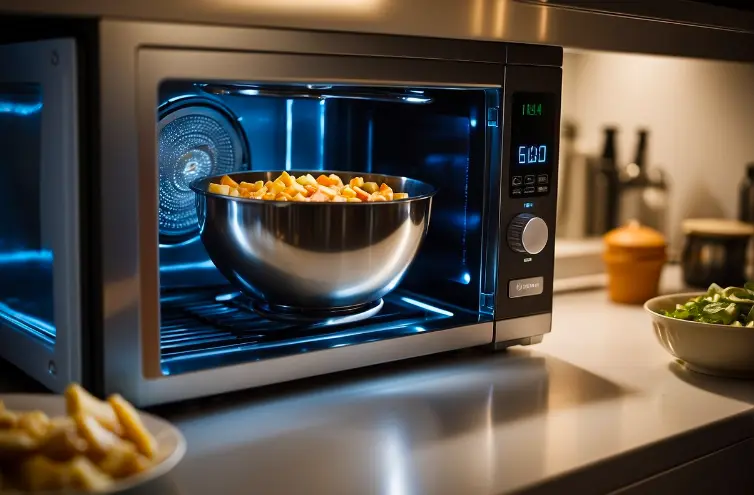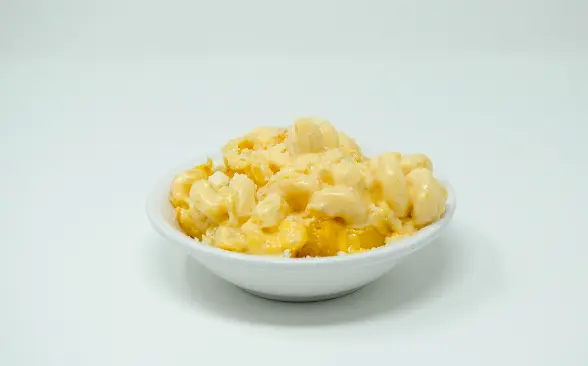I often come across the question of whether you can put a metal bowl in the microwave. It’s a common concern for many who are used to the convenience of quickly reheating or cooking food in a microwave. The idea that metal should not be used in microwaves is nearly as old as microwaves themselves, due to safety and functionality concerns. However, with advancements in technology and materials, the answer isn’t as simple as a blanket “no” anymore.

From my experience and knowledge on the subject, the use of metal bowls in a microwave hinges on several factors. For instance, a stainless steel bowl might be used under certain conditions. The bowl should not touch the sides of the microwave or any other metal object, and it mustn’t have jagged edges, which can cause sparks due to arcing. If a bowl is specifically labeled as microwave-safe by the manufacturer, it can usually be assumed that the company has tested it for safety and functionality in microwave use.
However, caution is always paramount. To preserve both the microwave and personal safety, it’s best to follow the guidelines set by appliance manufacturers. When in doubt, I opt for containers made from materials that are universally recognized as microwave-safe, such as glass or ceramic. It’s better to be safe and avoid damaging the appliance or risking a fire.
Understanding Microwaves
In this section, I’ll guide you through the fundamental principles that make microwave ovens a staple in modern kitchens. Let’s break down their operation and the role of electromagnetic waves.
How Microwave Ovens Work
A microwave oven transforms electric energy into microwave energy, which it then directs into the cooking chamber. These microwaves are a form of electromagnetic waves, specifically tuned to excite water molecules found in food. When the microwave energy encounters water molecules, it causes them to vibrate rapidly. This vibration generates heat, which cooks the food from the inside out. Unlike conventional ovens that heat from the outside, microwaves allow for a quicker cooking process by directly heating the water molecules within the food.
The Role of Electromagnetic Waves
Electromagnetic waves are the carriers of microwave energy. These waves are part of the electromagnetic spectrum and have a characteristic frequency that interacts with water molecules. It’s this specific interaction that rapidly heats food in the microwave oven through a process known as dielectric heating. It’s important to understand that these are not heat waves in the traditional sense; instead, the heat is a byproduct of the water molecules’ agitation caused by the microwaves.
Materials and Microwave Compatibility

In this section, I’ll explore which materials are suited for microwave use and the inherent risks of microwaving metal objects. Understanding the compatibility between various materials and microwaves is crucial for safe and effective cooking.
Safe Materials for Microwave Use
Glass containers are among the best materials for microwave use. They are typically unaffected by microwaves, allowing the waves to freely pass through and heat the food directly. Plastic containers can also be safe, but only if they are labeled as microwave-safe. These plastics are custom designed to withstand the heat produced inside a microwave without melting or releasing harmful chemicals.
- Best Material: Glass container
- Safe Synthetic: Microwave-safe plastic container
Risks of Using Metal in Microwaves
Microwaving metal objects, like a stainless steel container, is generally deemed unsafe. Metal can reflect microwaves, causing arcing, which might damage the microwave’s interior or even start a fire. Moreover, microwaves cannot penetrate metal, so the food inside a metal bowl may remain cold while the container itself gets too hot to handle.
- Metal Risk: Arcing and Fire hazard
- Steel Caution: Stainless steel container is typically not safe
Potential Hazards of Metals in Microwaves

When placing metals inside a microwave, it’s crucial to understand the risks involved. These include fire hazards and uneven heat distribution which can harm both the microwave and the user.
Electrical Sparks and Fire Hazards
Electrical sparks can occur when microwaves interact with metal objects, especially those with sharp or jagged edges. The microwaves cause electric currents to flow through the metal, and when the metal has pointed tips or edges, it concentrates the electric energy, causing sparks. These sparks can lead to fires, presenting a significant fire hazard.
Heat Distribution and Hot Spots
Metals in microwaves can lead to high temperatures and cause hot spots due to uneven heat distribution. Instead of the microwaves being absorbed by the food, they reflect off the metal. This reflection can cause certain areas to overheat while others remain uncooked, making the handling of containers and food dangerous due to the potential for burns.
Proper Use of Metal Containers

When incorporating metal containers like racks, cookware, lunch boxes, or utensils with metal handles into microwave cooking, I understand the need for vigilance. Below, I’ll outline when it is suitable to use these items and the precautions to take to avoid damage to both the microwave and the items.
When To Use Metal Bowls
I can use metal bowls in the microwave under specific circumstances. For instance, manufacturers may indicate if their stainless steel lunch boxes or metal cookware are designed to be microwave-safe. To ensure safety, I look for a label or marker specifying that a metal bowl can be microwaved. Metal racks sometimes come as a part of the microwave design, intended to hold dishes for convection cooking, which is safe as long as manufacturer instructions are followed.
Precautions for Metal Utensils
When using metal utensils or any container with metal handles, the precautions I take cannot be understated. I ensure the following:
- Do Not Use if the metal is pointed or has jagged edges, as this can cause dangerous electric arcing.
- Do Not Use aluminum foil or bowls with metallic glazes that are prone to sparking.
- To avoid burns, I always use oven mitts when removing metal containers, as they can get very hot.
- I also check for the presence of a microwave-safe label to confirm compatibility with microwave use.
Alternatives to Metal in Microwaves

When using microwaves, I understand it’s crucial to choose containers that are safe and don’t risk damaging the appliance or affecting the food’s quality. Let’s examine the kind of materials that are suitable for microwaving.
Microwave-Safe Bowls and Plates
Microwave-safe bowls and plates are specifically designed to withstand microwave temperatures without warping or leaching chemicals into food. They often have a label indicating they are “microwave-safe.” Ceramic and some plastics fall into this category, though it’s important to check for the microwave-safe label.
Glass and Silicone Options
Glass containers are excellent for microwaving, as most glass bowls and dishes are inherently microwave-safe. Glass is non-reactive and heats evenly, making it a reliable option for consistent cooking. Silicone options also offer flexibility and heat-resistance, which make them suitable for a range of microwave applications. Microwave-safe silicone can go from the freezer to the microwave without any issues, ensuring safety and convenience for meal prep.
Microwave Myths and Misunderstandings
In exploring the world of microwaves, I’ve encountered various myths and misunderstandings, especially regarding the use of metal materials like aluminum foil and metal bowls. Let’s clarify these misconceptions and set the record straight.
Common Microwave Misconceptions
Aluminum Foil
Myth: All aluminum foil will cause sparks and fires in a microwave.
Truth: I understand that aluminum foil can be used sparingly in a microwave, provided it does not touch the sides and is shaped smoothly without sharp edges.
Metal Twist Ties
Myth: Metal twist ties are too small to be a concern in the microwave.
Truth: In reality, even small metal pieces like twist ties can cause sparks, so they should never be microwaved.
Debunking the Metal in Microwave Myth
Myth: Absolutely no metal can be microwaved under any circumstances.
Truth: Some modern microwaves are designed to accommodate certain types of metal objects without incident. However, this does not extend to all metal items, and caution is always advised.
The Stack Exchange Network is a resource I often turn to when I’m in doubt. It’s a collection of Q&A communities where real-world experiences with microwaving metal can be shared and discussed, offering practical insights into what might actually cause a reaction in your microwave.
When it comes to using metal in your microwave, always refer to the manufacturer’s instructions and heed the safety guidelines to prevent damage or fire hazards.
Microwaving Food Safely
When it comes to microwaving food safely, it’s crucial for me to be aware of the materials that are going into the microwave and understanding the exact times and power settings needed for different food products. Avoiding fires and properly cooking food are my top priorities.
How to Microwave Food Without Fires
To prevent fires in the microwave, I always use microwave-safe containers and supervise the cooking process. If microwaving food that tends to splatter, such as sauces or stews, I cover them with a microwave-safe lid or a layer of paper towels to contain splashes. Adding a splash of water to dishes that dry out can also help to prevent overheating and fire risks. It’s important not to use materials that can spark a fire, like aluminum foil or certain metals.
Recommended Cooking Times and Power Settings
I adhere to recommended cooking times and power settings by consulting the microwave’s manual or a reliable cooking guide. Here’s a quick reference table for common food items:
| Food Product | Cooking Time | Power Setting |
|---|---|---|
| Frozen Vegetables | 4-5 minutes | High |
| Leftover Pizza | 1-2 minutes | Medium |
| Raw Chicken Breast | 6-8 minutes | High |
| Baked Potato | 5-7 minutes | High |
Cooking times do vary based on the wattage of my microwave, so I check the food regularly and adjust as needed. It’s essential to let food stand for a couple of minutes after cooking, as this allows heat to distribute evenly.
Conclusion
In my exploration of whether metal bowls are suitable for microwave use, I’ve discovered that the practice is not black and white. Although conventional wisdom suggests keeping metal out of microwaves, certain types of metal bowls may be safe in specific circumstances, such as in convection microwaves which are designed to accommodate various materials. When using a metal bowl, I ensure it does not touch the interior walls of the microwave, as this can lead to serious damage.
The next time I microwave, I’ll check if my bowl is marked ‘microwave-safe’. If I’m uncertain, I’ll use a glass bowl instead. It’s not worth the risk.
Kitchen appliances, like microwaves, are vital in my daily cooking routines, and it’s crucial to understand how to use them effectively without causing harm to the appliance or myself. I advocate for caution and suggest consulting the microwave manufacturer’s guidelines to ensure compatibility.
Frequently Asked Questions
In this section, I’ll address some of the most common concerns about using metal in microwaves. It’s important to understand the science behind why certain materials are deemed safe or hazardous when combined with microwave technology.
What occurs if metal accidentally gets put into a microwave?
If metal is accidentally placed in a microwave, it can cause sparks or even a fire. The microwaves bounce off the metal, potentially causing electrical arcing. If you notice this happening, immediately turn off the microwave and carefully open the door to halt the reaction.
Are stainless steel utensils safe to use in a microwave convection oven?
Generally, stainless steel utensils are not safe to use in a microwave convection oven. Stainless steel obstructs the flow of microwaves, preventing food from heating properly and potentially causing damage to the appliance.
Is it possible to microwave food in stainless steel cups?
Microwaving food in stainless steel cups is not recommended. Like other metal objects, stainless steel can reflect microwaves and cause sparks. It’s best to transfer food into microwave-safe containers before heating.
What should I do if I have microwaved a metal dish by mistake?
If you’ve microwaved a metal dish by mistake, stop the microwave immediately. Allow the microwave to cool down before you attempt to remove the metal object. Check for any damage inside the microwave before using it again.
Can placing a metal spoon in the microwave cause any hazards?
Placing a metal spoon in the microwave can cause hazards like electrical arcs. The metal can reflect microwaves and create sparks, which can damage the appliance or start a fire. Always remove metal items before microwaving.
Under what circumstances is it safe to use a metal bowl in a microwave?
Using a metal bowl in a microwave is safe only if it is specifically labeled as microwave-safe by the manufacturer. These products are designed to avoid the issues standard metal containers cause in microwaves.
Microwave Mac ‘n’ Cheese Cups: Quick & Kid-Approved!
Course: LunchCuisine: AmericanDifficulty: Easy4
servings5
minutes10
minutesWith Microwave Mac ‘n’ Cheese Cups, dinner is served in a flash, leaving more time for fun and family moments!
Ingredients
1 ½ cups elbow macaroni
2 cups water
1 cup milk
2 cups shredded cheddar cheese (or your favorite cheese blend)
2 tablespoons butter
Salt and pepper to taste
Directions
- In a microwave-safe bowl, combine the elbow macaroni and water.
- Microwave on high for 8-10 minutes, stirring halfway through, until the macaroni is cooked and tender.
- Carefully drain any excess water from the bowl.
- Stir in the milk, shredded cheddar cheese, butter, salt, and pepper until well combined.
- Microwave on high for an additional 1-2 minutes, or until the cheese is melted and the sauce is creamy, stirring every 30 seconds to prevent burning.
- Let it cool for a minute or two, then portion the mac ‘n’ cheese into kid-friendly cups or bowls.
- Serve with a smile and watch as your little ones gobble up this cheesy goodness!

